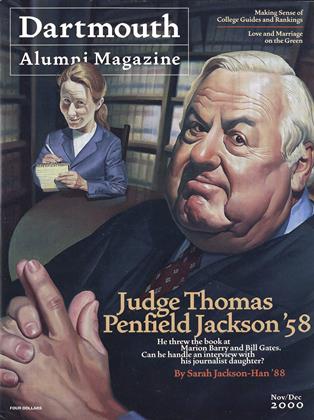To lay a foundation for building community, Dartmouth must solve its student housing shortage.
DARTMOUTH IS ARESIDENTIAL college—this is our history and our strength. We offer students a first-rate liberal arts education at one of the most beautiful cam- puses in the world. Without question, residential life at Dart- mouth should be second to none. For this reason, Dart- mouth will begin the planning and construction of new hous- ing for up to 500 undergraduates and 110 graduate students.
Let me rake this opportunity to explain why our residential needs have grown so much in recent years.
Increases in enrollment are only part of the story. When I started teaching at Dartmouth in 1969, enrollment at the College stood at 3,200 students. The introduction of coeducation in the early 1970s boosted enrollment to some 4,000 students.The College absorbed the extra students, without expanding the campus, by moving to year-round operation. Modest growth since then has brought us to our current size of 4,300 students, of whom only 3,800 are typically in residence. (The remainder either participate in off-campus programs or are on leave terms.) We have no plans to increase enrollment above this number.
Our commitment to being a residential college means that Dartmouth should have enough space on campus to house all 3,800 students. At present the Office of Residential Life can accommodate 3,010 students, with another 243 students living in privately owned coed, fraternity and sorority houses. Several factors have contributed to the imbalance between our housing stock and the number of students needing housing. In the early 1980s a curricular change—requiring students to complete 12 rather than 11 terms of study—increased the demand for housing by about 300 beds a year. Decreasing enrollments in off-campus programs, from a high of 800 in 1982-83 to around 600 students today have exacerbated the problem. (For various reasons, including an increase in the number of science majors at the College, language programs have experienced most of the decline.) In addition, we have lost beds over the past 20 years as we have brought our older residence halls into line with current building codes and have converted some rooms into much-needed social and study spaces. To accommodate as many students as possible, we have converted many singles into doubles and doubles into triples. But crowding students into existing rooms is not a viable long-term solution.
Nor do we wish to solve our overcrowding by encouraging students to live off campus. Approximately 600 undergraduates had to live off campus in the fall of 1999, but many of these students would have preferred to live on campus. While it is likely that some students will continue to choose to live off campus, we must make it possible for all students who want to live on campus to do so.
Bringing students onto campus means bringing them more fully into Dartmouth. The quality of the out-of-classroom experience has a direct impact on the way students perform in the classroom. If we are to expect the most from our students and push them to the maximum intellectually, if we want them to learn from each other and forge strong friendships that will last a lifetime, we need to provide them with a residential experience that fosters interaction and a sense of community. We would like to increase continuity in our students' lives by offering them the opportunity to live in one or two residence halls for their entire Dartmouth careers, if they so choose, an option not available at present.
Our newest residence hall, McCullough Hall, which opened this fall, is a door to our future. Housing 80 students, it features spacious rooms and common areas designed to facilitate social interaction. During the next five years we hope to take care of our immediate needs by building additional residential space to house up to 500 students. Once this first phase is complete, the College will evaluate the need for a second phase of construction: The Choates are slated for either renovation or replacement, and we could replace the River Cluster, which is more ideally suited for Tuck and Thayer expansions than undergraduate housing.
We also see a need for more graduate student housing. Whittemore Hall, the Tuck School's newly completed residence hall, is now available to house 60 business students and to serve as a focal point for Tuck community life. We would like to offer graduate students in the arts and sciences, Dartmouth Medical School and Thayer School of Engineering the opportunity to benefit from the sense of shared purpose and community that oncampus graduate housing would provide.
It is time to convert our visions for residential life into bricks and mortar. This year we will decide locations for new residences, choose architects and begin to draw up plans. We hope to break ground by the summer of 2001. By improving the quality of life for our undergraduate and graduate students, each of these residential projects will help to keep Dartmouth at the forefront of American higher education.
 View Full Issue
View Full Issue
More From This Issue
-
 Cover Story
Cover StoryFather In Law
November | December 2000 By SARAH JACKSON-HAN ’88 -
 Feature
FeatureAnd the Bride Wore Green
November | December 2000 By MEG SOMMERFELD ’90 -
 Feature
FeaturePolitical Junkie
November | December 2000 By Jake Tapper ’91 -
 Feature
FeatureWISDOM OF THE GUIDES
November | December 2000 -
 Feature
FeatureOVER-RATED
November | December 2000 -
 Feature
FeatureWHAT STUDENTS SAY
November | December 2000
President James Wright
-
 Article
ArticleVaried Experiences, Common \alues
DECEMBER 1999 By President James Wright -
 Article
ArticleWhere Do We Go From Here?
JANUARY 2000 By President James Wright -
 Presidential Range
Presidential RangeTaking Initiative
MARCH 2000 By President James Wright -
 Article
ArticleBrave New World
Sept/Oct 2000 By President James Wright -
 Article
ArticleThe Global College
Jan/Feb 2001 By President James Wright -
 Article
ArticleAcademic Aesthetics
Sept/Oct 2002 By President James Wright







